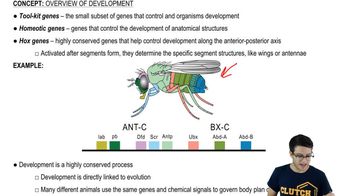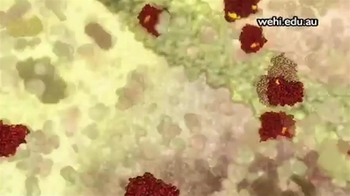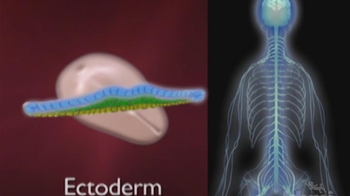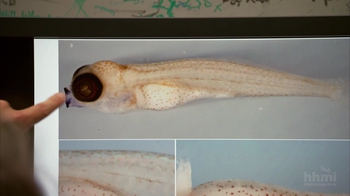Table of contents
- 1. Introduction to Biology2h 42m
- 2. Chemistry3h 40m
- 3. Water1h 26m
- 4. Biomolecules2h 23m
- 5. Cell Components2h 26m
- 6. The Membrane2h 31m
- 7. Energy and Metabolism2h 0m
- 8. Respiration2h 40m
- 9. Photosynthesis2h 49m
- 10. Cell Signaling59m
- 11. Cell Division2h 47m
- 12. Meiosis2h 0m
- 13. Mendelian Genetics4h 44m
- Introduction to Mendel's Experiments7m
- Genotype vs. Phenotype17m
- Punnett Squares13m
- Mendel's Experiments26m
- Mendel's Laws18m
- Monohybrid Crosses19m
- Test Crosses14m
- Dihybrid Crosses20m
- Punnett Square Probability26m
- Incomplete Dominance vs. Codominance20m
- Epistasis7m
- Non-Mendelian Genetics12m
- Pedigrees6m
- Autosomal Inheritance21m
- Sex-Linked Inheritance43m
- X-Inactivation9m
- 14. DNA Synthesis2h 27m
- 15. Gene Expression3h 20m
- 16. Regulation of Expression3h 31m
- Introduction to Regulation of Gene Expression13m
- Prokaryotic Gene Regulation via Operons27m
- The Lac Operon21m
- Glucose's Impact on Lac Operon25m
- The Trp Operon20m
- Review of the Lac Operon & Trp Operon11m
- Introduction to Eukaryotic Gene Regulation9m
- Eukaryotic Chromatin Modifications16m
- Eukaryotic Transcriptional Control22m
- Eukaryotic Post-Transcriptional Regulation28m
- Eukaryotic Post-Translational Regulation13m
- 17. Viruses37m
- 18. Biotechnology2h 58m
- 19. Genomics17m
- 20. Development1h 5m
- 21. Evolution3h 1m
- 22. Evolution of Populations3h 52m
- 23. Speciation1h 37m
- 24. History of Life on Earth2h 6m
- 25. Phylogeny2h 31m
- 26. Prokaryotes4h 59m
- 27. Protists1h 12m
- 28. Plants1h 22m
- 29. Fungi36m
- 30. Overview of Animals34m
- 31. Invertebrates1h 2m
- 32. Vertebrates50m
- 33. Plant Anatomy1h 3m
- 34. Vascular Plant Transport1h 2m
- 35. Soil37m
- 36. Plant Reproduction47m
- 37. Plant Sensation and Response1h 9m
- 38. Animal Form and Function1h 19m
- 39. Digestive System1h 10m
- 40. Circulatory System1h 57m
- 41. Immune System1h 12m
- 42. Osmoregulation and Excretion50m
- 43. Endocrine System1h 4m
- 44. Animal Reproduction1h 2m
- 45. Nervous System1h 55m
- 46. Sensory Systems46m
- 47. Muscle Systems23m
- 48. Ecology3h 11m
- Introduction to Ecology20m
- Biogeography14m
- Earth's Climate Patterns50m
- Introduction to Terrestrial Biomes10m
- Terrestrial Biomes: Near Equator13m
- Terrestrial Biomes: Temperate Regions10m
- Terrestrial Biomes: Northern Regions15m
- Introduction to Aquatic Biomes27m
- Freshwater Aquatic Biomes14m
- Marine Aquatic Biomes13m
- 49. Animal Behavior28m
- 50. Population Ecology3h 41m
- Introduction to Population Ecology28m
- Population Sampling Methods23m
- Life History12m
- Population Demography17m
- Factors Limiting Population Growth14m
- Introduction to Population Growth Models22m
- Linear Population Growth6m
- Exponential Population Growth29m
- Logistic Population Growth32m
- r/K Selection10m
- The Human Population22m
- 51. Community Ecology2h 46m
- Introduction to Community Ecology2m
- Introduction to Community Interactions9m
- Community Interactions: Competition (-/-)38m
- Community Interactions: Exploitation (+/-)23m
- Community Interactions: Mutualism (+/+) & Commensalism (+/0)9m
- Community Structure35m
- Community Dynamics26m
- Geographic Impact on Communities21m
- 52. Ecosystems2h 36m
- 53. Conservation Biology24m
20. Development
Developmental Biology
Problem 8`
Textbook Question
Which of the following provides the strongest evidence for the conservation of tool-kit genes?
a. Bicoid moved from one fly embryo into the posterior of another fly embryo causes the formation of two head regions.
b. Mutation of an unrelated gene in another species of fly has a similar effect to mutation of bicoid in Drosophila.
c. A mouse Hox gene can be used to take over the function of a mutated Drosophila Hox gene.
d. Sheep can be cloned by fusing a differentiated adult cell with an enucleated egg.
 Verified step by step guidance
Verified step by step guidance1
Understand the concept of tool-kit genes: Tool-kit genes are a set of genes that control the development of an organism's body plan. They are highly conserved across different species, meaning they have remained relatively unchanged throughout evolution.
Analyze option a: This option describes an experiment involving the bicoid gene, which is a tool-kit gene in flies. Moving bicoid from one embryo to another and causing the formation of two head regions demonstrates its role in development but does not directly show conservation across species.
Analyze option b: This option involves a mutation in an unrelated gene in another species of fly having a similar effect to a mutation in bicoid in Drosophila. This suggests functional similarity but not necessarily conservation of tool-kit genes across different species.
Analyze option c: This option describes a mouse Hox gene taking over the function of a mutated Drosophila Hox gene. Hox genes are a type of tool-kit gene, and this cross-species functionality strongly indicates conservation of these genes across different organisms.
Analyze option d: This option involves cloning sheep, which is a process of creating a genetically identical organism. While it involves genetic manipulation, it does not directly relate to the conservation of tool-kit genes across species.
 Verified video answer for a similar problem:
Verified video answer for a similar problem:This video solution was recommended by our tutors as helpful for the problem above
Video duration:
2mPlay a video:
Was this helpful?
Key Concepts
Here are the essential concepts you must grasp in order to answer the question correctly.
Tool-kit Genes
Tool-kit genes are a set of genes that control the development of an organism's body plan and structure. These genes are highly conserved across different species, meaning they have remained relatively unchanged throughout evolution. Their conservation suggests a fundamental role in developmental processes, allowing for the study of genetic functions across diverse organisms.
Recommended video:
Guided course

Genes & Alleles
Hox Genes
Hox genes are a subset of tool-kit genes that determine the identity and arrangement of body segments along the anterior-posterior axis in animals. They are crucial for proper development and are conserved across many species, from fruit flies to mammals. The ability of a mouse Hox gene to substitute for a Drosophila Hox gene highlights their functional conservation and interchangeability across species.
Recommended video:
Guided course

Hox Genes
Gene Conservation
Gene conservation refers to the phenomenon where certain genes remain unchanged across different species over evolutionary time. This conservation indicates that these genes perform essential functions that are critical for survival and development. Evidence of gene conservation can be seen when genes from one species can functionally replace similar genes in another species, demonstrating their universal role in biological processes.
Recommended video:
Guided course

Conservation Biology and Biodiversity

 5:28m
5:28mWatch next
Master Cell Division and Differentiation with a bite sized video explanation from Jason
Start learningRelated Videos
Related Practice



























![Drosophila Embryogenesis - Anterior/Posterior Patterning [English Captions]](https://img.youtube.com/vi/ZOzKXrOGtgw/mqdefault.jpg)



















